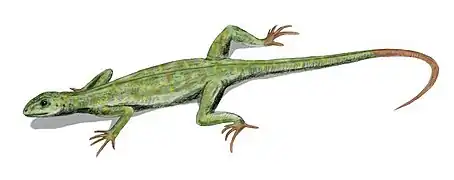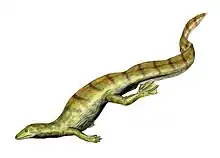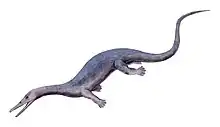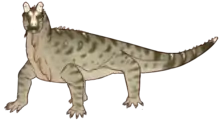Kuehneosauridae
Kuehneosauridae is an extinct family of small, lizard-like gliding diapsids known from the Triassic period of Europe and North America.
| Kuehneosauridae Temporal range: Triassic, | |
|---|---|
 | |
| Life restoration of Kuehneosuchus and Kuehneosaurus | |
| Scientific classification | |
| Domain: | Eukaryota |
| Kingdom: | Animalia |
| Phylum: | Chordata |
| Class: | Reptilia |
| Clade: | Sauria |
| Family: | †Kuehneosauridae Romer, 1966[1] |
| Genera | |
Description and systematics
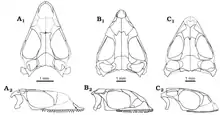
They are distinguished from other diapsids by their 'wings' formed by elongated ribs. These allowed the animal to glide and parachute similar to living gliding lizards. They were most likely insectivorous, judging from their pin-like teeth. They are often, but not always, placed in the group Lepidosauromorpha,[2] though other studies have recovered them in other positions within Sauria, including Archosauromorpha.[3]
The oldest and most primitive known member is Pamelina from the Early Triassic (Olenekian stage) of Poland, which already has vertebrae with characteristics consistent with gliding or parachuting.[2] Icarosaurus is known from a single specimen from the Carnian-aged Lockatong Formation of New Jersey.[4] The Late Triassic (Norian stage) kuehneosaurids from England, Kuehneosaurus and Kuehneosuchus, are very similar and can be distinguished from one another primarily on the length of their "wing" ribs, relatively short and massive in Kuehneosaurus but longer and more gracile in Kuehneosuchus. Kuehneosaurus was likely only capable of parachuting, while Kuehneosuchus could probably glide.[5] Rhabdopelix may have been a kuehneosaurid; however, the fossils were lost, and the characteristics described are not entirely consistent with the other family members.[4]
Kuehneosaurids were not the first flying vertebrates. Weigeltisaurids ("Coelurosauravidae") that lived as long ago as the Late Permian also had elongated ribs, to which membranes were attached for gliding. But the anatomy of these groups is too different to consider them close relatives, although both weigeltisaurids and kuehneosaurids belong to diapsid reptiles.[5]
Phylogeny
The cladogram below follows a 2009 analysis by paleontologists Susan E. Evans and Magdalena Borsuk−Białynicka.[6]
| Diapsida |
| ||||||||||||||||||||||||||||||||||||||||||||||||||||||
See also
References
- "†family Kuehneosauridae Romer 1966". Paleobiology Database. Fossilworks. Retrieved 17 December 2021.
- Susan E. Evans (2009). "An early kuehneosaurid reptile (Reptilia: Diapsida) from the Early Triassic of Poland" (PDF). Paleontologica Polonica. 65: 145–178. Archived from the original (PDF) on August 31, 2021.
- Pritchard, Adam C. & Nesbitt, Sterling J. (2017-10-01). "A bird-like skull in a Triassic diapsid reptile increases heterogeneity of the morphological and phylogenetic radiation of Diapsida". Royal Society Open Science. 4 (10): 170499. Bibcode:2017RSOS....470499P. doi:10.1098/rsos.170499. PMC 5666248. PMID 29134065.
- Colbert, Edwin H. (1966). "A gliding reptile from the Triassic of New Jersey" (PDF). American Museum Novitates (3282): 1–23. Archived from the original (PDF) on June 11, 2007. Retrieved 2007-08-01.
- Stein, Koen; Palmer, Colin; Gill, Pamela G. & Benton, Michael J. (July 2008). "The aerodynamics of the British Late Triassic Kuehneosauridae". Palaeontology. 51 (4): 967–981. doi:10.1111/j.1475-4983.2008.00783.x. S2CID 130582988.
- Susan E. Evans & Magdalena Borsuk−Białynicka (2009). "A small lepidosauromorph reptile from the Early Triassic of Poland" (PDF). Paleontologica Polonica. 65: 179–202. Archived from the original (PDF) on 2016-03-03. Retrieved 2023-09-29.


